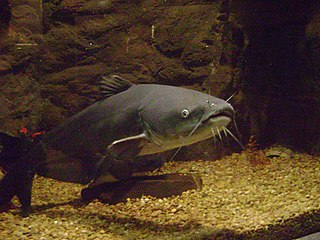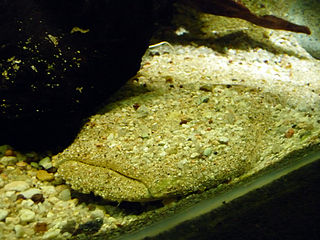
Catfish are a diverse group of ray-finned fish. Named for their prominent barbels, which resemble a cat's whiskers, catfish range in size and behavior from the three largest species alive, the Mekong giant catfish from Southeast Asia, the wels catfish of Eurasia and the piraíba of South America, to detritivores, and even to a tiny parasitic species commonly called the candiru, Vandellia cirrhosa. There are armour-plated types and there are also naked types, neither having scales. Despite their name, not all catfish have prominent barbels. Members of the Siluriformes order are defined by features of the skull and swimbladder. Catfish are of considerable commercial importance; many of the larger species are farmed or fished for food. Many of the smaller species, particularly the genus Corydoras, are important in the aquarium hobby. Many catfish are nocturnal, but others are crepuscular or diurnal.

The blue catfish is the largest species of North American catfish, reaching a length of 165 cm (65 in) and a weight of 68 kg (150 lb). The typical length is about 25–46 in (64–117 cm). The fish can live to 20 years. The native distribution of blue catfish is primarily in the Mississippi River drainage, including the Missouri, Ohio, Tennessee, and Arkansas Rivers, and the Rio Grande, and south along the Gulf Coast to Belize and Guatemala. These large catfish have also been introduced in a number of reservoirs and rivers, notably the Santee Cooper lakes of Lake Marion and Lake Moultrie in South Carolina, the James River in Virginia, Powerton Lake in Pekin, Illinois, and Springfield Lake in Springfield, Illinois. This fish is also found in some lakes in Florida. The fish is considered an invasive pest in some areas, particularly the Chesapeake Bay. Blue catfish can tolerate brackish water, thus can colonize along inland waterways of coastal regions.

The Mekong giant catfish, is a large, critically endangered species of catfish in the shark catfish family (Pangasiidae), native to the Mekong basin in Southeast Asia and adjacent China. In Thai folklore, this fish is regarded with reverence, and special rituals are followed and offerings are made before fishing it.

Clarias is a genus of catfishes of the family Clariidae, the airbreathing catfishes. The name is derived from the Greek chlaros, which means lively, in reference to the ability of the fish to live for a long time out of water.

The Doradidae are a family of catfishes also known as thorny catfishes or talking catfishes. These fish are native to South America, primarily the Amazon basin and the Guianas.

Basa is a species of catfish in the family Pangasiidae. Basa are native to the Mekong and Chao Phraya basins in Indochina. These fish are important food fish with an international market. They are often labelled in North America and Australia as "basa fish", "swai", or "bocourti". In the UK all species of Pangasius may legally be described as "river cobbler", "cobbler", "basa", "pangasius", "panga", or any of these with the addition of "catfish". In the rest of Europe, these fish are commonly marketed as "pangasius" or "panga". Other related shark catfish may occasionally be incorrectly labeled as basa fish, including P. hypophthalmus and P. pangasius.

The Pseudopimelodidae are a small family of catfishes known as the bumblebee catfishes or dwarf marbled catfishes. Some of these fish are popular aquarium fish.

Striped Raphael catfish is a catfish of the family Doradidae. It may also be called Southern striped Raphael, talking catfish, chocolate doradid, chocolate catfish or thorny catfish. It is native to the Amazon, Paraguay–Paraná and lower Orinoco basins in South America. This peaceful, nocturnal species is a popular aquarium fish due to its pleasant temperament and curious nature.
Raphael catfish may refer to a number of different South American doradid catfish species:

Anadoras is a genus of thorny catfishes native to tropical South America.
Amblydoras is a genus of thorny catfishes native to rivers in tropical South America.

Leiarius is a genus of long-whiskered catfishes native to South America. Most of the genus' species are found in the aquarium hobby as ornamental fish.
Synodontis afrofischeri, known as Fischer's Victoria squeaker, the marbled Victoria squeaker, Fischer's catfish, or the Victoria synodontis, is a species of upside-down catfish native to Kenya, Rwanda, Tanzania and Uganda. It was first described by German zoologist Franz Martin Hilgendorf in 1888, based upon a holotype discovered in Lake Victoria. The specific name "afrofischeri" is in honor of the German researcher Dr. Gustav Fischer, a German explorer of Africa.
Amblydoras affinis is a species of thorny catfish found in Bolivia, Brazil and Guyana. It is found in the basins of the Guaporé, Branco and Essequibo Rivers. This species grows to a length of 10.0 centimetres (3.9 in) SL.
Amblydoras bolivarensis is a species of thorny catfish endemic to Venezuela where it is found in the Orinoco River basin. This species grows to a length of 10.2 centimetres (4.0 in) SL.
Amblydoras gonzalezi is a species of thorny catfish found in Colombia and Venezuela. It occurs in the Orinoco River basin and in the Casiquiare canal. This species grows to a length of 9.8 centimetres (3.9 in) SL.
Amblydoras monitor is a species of thorny catfish that occurs in the upper Amazon Basin where it can be found in the countries of Brazil, Colombia and Peru. This species grows to a length of 9.0 centimetres (3.5 in) SL.
Synodontis albolineatus, known as the mustard catfish, or the mustard squeaker, is a species of upside-down catfish native to Gabon and Cameroon, where it occurs in the Ntem and Ivindo rivers. It was first described by French zoologist Jacques Pellegrin in 1924, based upon a holotype discovered in the Djoua River at Madjingo, Gabon. The holotype specimen resides in the Musee National d' Histoire Naturelle de Paris. The specific name "albolineatus" is a composite from the Latin word albus for "white" and the Latin word linea for "line", which refers to the white midlateral stripe of the species.
Synodontis schoutedeni, known as the the yellow marbled Synodontis, is a species of upside-down catfish native to the Congo Basin of the Democratic Republic of the Congo and the Republic of the Congo. It was first described by Belgian ichthyologist Lore Rose David in 1936, based upon a holotype discovered in Basongo, in what is now the Democratic Republic of the Congo. The specific name "schoutedeni" is named after the Belgian zoologist Henri Schouteden.












